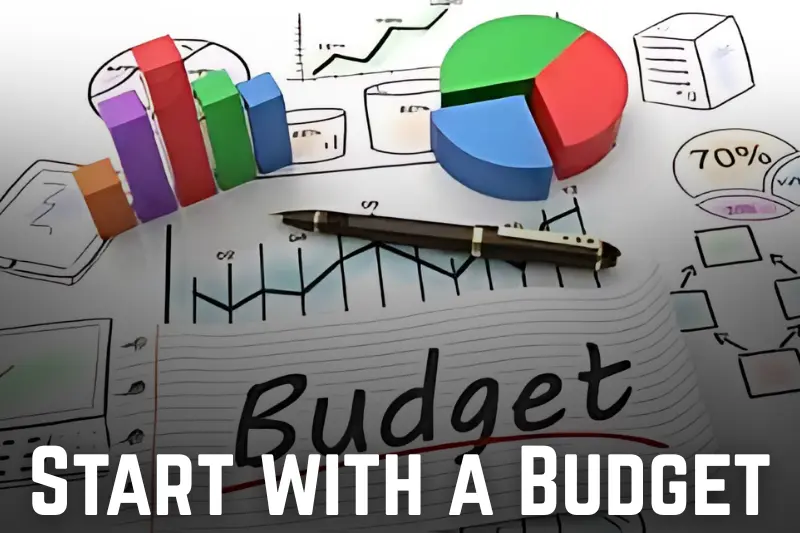Have you ever wondered how people with low incomes manage to save money? It’s easy to feel like saving is impossible when every dollar is spoken for. But what if there’s a way to make it work, even on a tight budget? In this post, we’ll explore smart, easy-to-follow strategies that can help you save money, no matter your income level.
Saving money on a low income can feel impossible, especially when you’re living paycheck to paycheck. It often seems like there’s no room in your budget for anything other than the basics, but the truth is, saving money is essential for your financial future, no matter your income. Even small amounts saved over time can add up and help you avoid financial stress in emergencies or reach your long-term goals.
In this post, we’ll show you how to save money on a low income by implementing simple strategies, like creating a budget, cutting unnecessary expenses, and finding extra sources of income. Whether you’re just starting or have tried before, these steps can help you begin saving today.
Start with a Budget

Creating a budget is the first step in managing your money effectively. It helps you understand how much you earn, how much you spend, and where you can make adjustments to start saving. Here’s how to get started:
What is a Budget?
- A budget is a tool that tracks your income and expenses.
- It helps you see how much money you have coming in and where it is going.
- By creating a budget, you can make informed decisions about your finances.
Steps to Create a Budget
- List Your Income
- Write down all sources of income you receive regularly (salary, side gigs, etc.).
- Example: “If you earn $2,000 a month from your job and $300 from a side job, your total income is $2,300.”
- Track Your Expenses
- List all your monthly expenses, including rent, utilities, groceries, and any subscriptions.
- Example: “If you pay $800 for rent, $100 for utilities, and $200 for groceries, your total expenses are $1,100.”
- Identify Areas to Cut Back
- Look for areas where you can reduce spending without sacrificing essentials.
- Example: “If you spend $100 a month on takeout, could you reduce it by cooking at home or meal prepping?”
Tools to Help You
There are several free apps that can make budgeting easier and more organized:
- Mint
- Mint is a popular app that automatically tracks your expenses and helps you categorize your spending.
- Example: “Using Mint, you can easily see how much you’re spending on entertainment versus savings.”
- YNAB (You Need A Budget)
- YNAB helps you allocate your income towards specific goals, like bills or savings.
- Example: “YNAB can show you how much you can save each month after your essential expenses.”
You may also like it:
Personal Finance Guide: Tips for Financial Success
Smart Home Trends: Top Innovations for 2025
Easy Budgeting Tips: Manage Your Money Smartly
Cut Unnecessary Expenses
Cutting unnecessary expenses is one of the best ways to start saving money, especially when you’re on a low income. By focusing on what you truly need, you can free up money for savings or other financial goals.
Prioritize Needs Over Wants
- Essential Expenses First
- Focus on spending money only on essentials like rent, utilities, and food.
- Example: “Ensure that basic living costs come first before considering any non-essential purchases.”
- Limit Luxury Items
- Cut back on luxury items or services that you don’t absolutely need, like cable or fancy clothes.
- Example: “Opt for an affordable phone plan instead of paying for high-end features you rarely use.”
- Trim Subscriptions and Services
- Review your subscriptions and cancel any that you don’t use often.
- Example: “You might not need every streaming service—consider canceling the one you use the least.”
- Look for Cheaper Alternatives
- Think about cheaper alternatives for non-essential items.
- Example: “Switching to a more affordable coffee option can save you money in the long run.”
Small Changes Add Up
Sometimes, it’s the little changes that make the biggest difference when it comes to saving money. Here are some easy adjustments you can make:
- Cancel Unused Subscriptions
- If you have subscriptions you don’t use, cancel them.
- Example: “If you haven’t used your gym membership in months, consider canceling it and finding free workout options online.”
- Buy Generic Brands
- Switch to generic or store-brand items, which often cost less than name-brand products.
- Example: “Buying generic groceries can save you hundreds each year without compromising quality.”
- Walk Instead of Using Public Transport
- If possible, walk or bike to save on transportation costs.
- Example: “Walking to the store or your workplace can cut down on bus or taxi fares.”
- Avoid Impulse Purchases
- Don’t buy things on the spot—give yourself 24 hours to decide.
- Tip: “Waiting a day before making a purchase can prevent buying things you don’t need.”
Save on Groceries
Groceries can be one of the biggest expenses, but with a few smart strategies, you can reduce what you spend each month. Here’s how you can save money on groceries without sacrificing quality or nutrition.
Plan Your Meals
- Why Meal Planning Works
- Planning your meals for the week helps you avoid last-minute shopping trips and unnecessary purchases.
- Example: “A weekly meal plan can help you stick to a shopping list and avoid buying things you don’t need.”
- Reduce Food Waste
- By planning meals ahead, you’ll only buy what you need, which means less food gets thrown away.
- Example: “If you have a meal plan, you’ll use all the ingredients you buy instead of letting them spoil.”
- Save Time and Money
- Planning meals allows you to cook in bulk, which can save both time and money.
- Example: “Cooking large portions of meals like soups or stews will stretch your groceries and provide leftovers for several days.”
- Stick to a Shopping List
- Creating a list based on your meal plan helps you avoid impulse buys.
- Tip: “Stick to the list and avoid wandering the aisles, which can tempt you into buying non-essential items.”
Use Coupons and Discounts
- Coupons Can Add Up
- Using coupons, whether from newspapers or apps, can help you save on items you already buy.
- Example: “You can save $1 or $2 on your favorite brands just by clipping coupons or checking apps like Honey.”
- Discount Cards and Loyalty Programs
- Many stores offer discount cards or loyalty programs that give you discounts on regular purchases.
- Example: “Signing up for a store’s loyalty card can unlock exclusive discounts, helping you save on every grocery trip.”
- Shop During Sales
- Take advantage of sales and promotions to stock up on items you use frequently.
- Example: “Buying items on sale can help you save money, but remember only buy what you can use before it expires.”
- Online Savings with Apps
- Apps like Honey can help you find the best coupons when shopping online, lowering your grocery costs.
- Tip: “Before checking out online, use Honey to search for discount codes that can be applied to your order.”
Buy in Bulk
- Save on Non-Perishable Items
- Bulk buying is often cheaper for non-perishable items like rice, pasta, canned goods, and cleaning products.
- Example: “Buying a large bag of rice or pasta can save you money per unit in the long run.”
- Reduce Packaging Costs
- Buying in bulk often reduces the amount of packaging, which can lower the price per item.
- Example: “Bulk purchasing items like flour or sugar reduces packaging costs and allows you to buy more for less.”
- Long-Term Savings
- Although bulk items cost more upfront, they save you money over time since you’ll be purchasing less often.
- Example: “Stocking up on pantry staples can lower your monthly grocery bill and prevent emergency runs to the store.”
- Use Bulk Stores or Warehouse Clubs
- Consider shopping at warehouse stores like Costco for bulk items to get the best prices.
- Tip: “If you have a membership, you can get even better deals on bulk purchases, especially for large families.”
Find Extra Sources of Income

Finding additional income streams can make a big difference, especially when you’re working with a low income. Here are some practical ways to boost your earnings:
Side Gigs
- Easy-to-Start Jobs
- Side gigs are flexible jobs that you can start with little to no experience. Examples include dog walking, freelance writing, and food delivery.
- Example: “Many people make extra cash by becoming a driver for services like Uber or Lyft.”
- Dog Walking or Pet Sitting
- If you love animals, dog walking or pet sitting can be a simple way to earn extra money.
- Tip: “You can sign up on platforms like Rover to find clients near you.”
- Freelance Writing or Graphic Design
- If you have skills in writing, graphic design, or web development, freelance work can bring in a steady income.
- Example: “Platforms like Fiverr or Upwork allow you to offer your services to clients globally.”
- Food Delivery or Rideshare
- Delivering food for services like DoorDash or becoming a rideshare driver with Lyft or Uber can give you extra cash whenever you have free time.
- Tip: “If you already have a car, these services can be a great way to make money with flexible hours.”
Sell Unused Items
- Declutter Your Home
- Look around your house for items you no longer need—clothes, electronics, or furniture that you can sell.
- Example: “Selling unused items on eBay or Facebook Marketplace can give you some extra cash.”
- Sell Old Electronics
- If you have old phones, laptops, or tablets, you can sell them for a good price online.
- Tip: “Websites like Gazelle or Decluttr make it easy to sell your electronics quickly and safely.”
- Sell Clothing and Accessories
- If your closet is full of clothes you no longer wear, selling them can give you some extra income.
- Example: “Platforms like Poshmark or ThredUp allow you to sell gently used clothing to people who want them.”
- Furniture and Household Goods
- If you’re upgrading your furniture or decluttering, consider selling old pieces.
- Tip: “Facebook Marketplace or Craigslist is great for selling furniture locally.”
Online Surveys and Tasks
- Simple Online Tasks
- Many websites pay you for completing simple tasks such as filling out surveys, testing products, or participating in market research.
- Example: “Sites like Swagbucks or InboxDollars reward you for completing surveys or watching videos.”
- Data Entry Jobs
- Some companies hire people for simple data entry jobs that you can do from home in your spare time.
- Tip: “Check platforms like Upwork or Freelancer for data entry opportunities.”
- Product Testing
- Companies often pay for your opinion on products before they’re launched to the public.
- Example: “Websites like Pinecone Research or Toluna offer compensation for testing and reviewing products.”
- Microtasks
- Microtask platforms like Amazon Mechanical Turk allow you to complete small online tasks for money.
- Tip: “These tasks can range from categorizing images to transcribing short audio clips, all of which can add up over time.”
Build an Emergency Fund
Having an emergency fund is one of the most important financial steps you can take, especially when living on a low income. This fund helps you cover unexpected costs without going into debt.
What is an Emergency Fund?
- A Safety Net for Unexpected Costs
- An emergency fund is money set aside for unexpected expenses, such as car repairs, medical bills, or urgent home repairs.
- Example: “If your car breaks down or you need an emergency dental visit, your emergency fund can cover the costs, preventing you from going into debt.”
- Peace of Mind
- Having an emergency fund gives you peace of mind knowing that you are financially prepared for the unexpected.
- Tip: “Start with small, manageable goals—aim for $500 as your first emergency fund.”
- How Much Should You Save?
- Ideally, an emergency fund should cover 3 to 6 months of essential living expenses, but starting small is better than nothing.
- Tip: “It’s okay to start small, and you can always grow the fund over time.”
How to Start Saving for It
- Set a Small, Achievable Goal
- Start with a modest goal, like saving $500. This is a good starting point for handling small emergencies.
- Example: “Try saving $5 every week—before you know it, you’ll have a cushion of $250 in 6 months.”
- Make Saving Automatic
- Set up an automatic transfer from your checking account to a savings account to make sure you save regularly.
- Tip: “Set up a weekly transfer of $5 or $10 to ensure you stay on track.”
- Cut Back on Non-Essential Spending
- Look for small ways to cut back on unnecessary expenses and redirect that money to your emergency fund.
- Example: “Skip the morning coffee run and save that $3 each day for your emergency fund.”
- Track Your Progress
- Keep an eye on your savings progress to stay motivated.
- Tip: “Celebrate small milestones, like reaching $100, to keep yourself motivated along the way.”
Conclusion
So guys, in this article, we’ve covered how to save money on a low income in detail. From creating a budget to finding extra sources of income, these strategies are simple but effective ways to put more money aside for your future. My personal recommendation is to start small—don’t feel overwhelmed by trying to do everything at once.
Pick one or two strategies and stick with them. Start saving today and watch your financial situation improve over time. Ready to take control of your finances? Start by budgeting your next paycheck!
FAQs: How to Save Money on a Low Income
How can I start saving money if I don’t have much to spare?
Start by setting a small, realistic goal, like saving $5 a week. Even small amounts add up over time. The key is consistency—make saving a regular habit, no matter how small the amount.
Is it really possible to save money on a low income?
Yes, it’s definitely possible! The key is to cut back on unnecessary expenses, create a budget, and look for ways to earn extra money. Saving, even in small amounts, can add up over time.
How can I save money on groceries?
You can save money by planning meals ahead, using coupons, and buying in bulk. Stick to a shopping list to avoid impulse buys. Look for discounts and shop during sales to maximize savings.
What should I prioritize when creating a budget?
Start with your essential expenses, like rent, utilities, and food. Then, look for areas where you can cut back, like subscriptions or eating out. Make sure to set aside a portion for savings, no matter how small.
How much should I have in an emergency fund?
Aim to save at least $500 as a starting point. This will cover smaller unexpected expenses. Over time, you can gradually build up to cover 3-6 months of living expenses for added security.
Can side gigs really make a difference in my savings?
Yes, side gigs like driving for Uber, dog walking, or freelance writing can help you earn extra money. Even just a few hours a week can bring in a significant amount over time. Use that extra money to boost your savings or pay off debt.
How do I avoid spending too much on non-essentials?
One tip is to wait 24 hours before making non-essential purchases to avoid impulse buys. Make a shopping list and stick to it, and cut back on unnecessary subscriptions or luxury items. Focus on your needs first, not your wants.
You may also like it:
Saving Money Tips for Students: Master Your Finances Now!
Startup Marketing Strategies: Boost Your Business Fast







